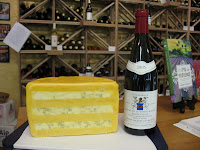First made in the Middle Ages by Benedictine Monks in the Fecht Valley, this Alsatian washed rind cheese is proof that monks have a sense of humor, and a pretty wicked one at that. Often described as "aromatic" or "pungent", Munster Gerome needs an entirely new word to do justice to its potency. "Well", you might think, "If it smells that bad it must be delicious. Otherwise, why would anyone eat it?" Why, indeed? Munster Gerome reminds me of the children's story, "The Emperor's New Clothes." Allow me to play the role of the innocent child here, and declare that the Emperor is naked, and that this cheese stinks to high heaven.
When I first unwrapped the package, I couldn't quite put my finger on one of the aromas layered in this cheese's arsenal. Caramel and something else. Then it hit me: burnt motor oil! Burnt motor oil from a Ford Pinto that's just been driven hard through a sewage treatment plant. I tasted it, hoping to be pleasantly surprised by the flavor. My hopes were dashed, and I smiled and swallowed so that I could convince my wife to try it.
"It's not bad," I lied.
"You don't love me'" she said, after taking a small bite.
Then she bet me five bucks that we wouldn't be able to sell it. Knowing that there are many people who love stinky cheese and also haven't read the "Emperor's New Clothes", I took the bet. A few hours later some friends of ours came by the cheese shop.
"Want to try something horrible" Jan asked. She held the Munster at arms length, pointing towards the husband. "Just smell it, first."
"I love stinky cheese," he said. "I detect under-notes of chocolate, and something else."
He took a bite, closed his eyes, swallowed, and asked for a quarter pound. Dumbfounded, we sliced and wrapped the cheese (by the way, in our cheese shop we say "sliced the cheese", rather than "cut", because I don't want to get a case of the giggles, but in this instance "cut the cheese" would have been far more appropriate) and handed it over.














